“You know you’re in Bangalore, you know you’re in the Silicon Valley of India, when you go to play golf and the caddy on the first tee says you can either aim at the Microsoft building or the IBM building. You know you’re in Bangalore when you see the Pizza Hut advertisement says ‘gigabytes of taste’,” famously said the US journalist Thomas Friedman in 2004. Ever since, reams have been written on outsourcing, the software boom and the rise of the uber-smart, uber-rich new technogeeks of Bangalore.
But whatever happened to the other Bangalores, the ones that shun the arc lights that the outsourcing world shines upon the city? What happened to the Bangalore that lives in its crowded markets, or the one that lives in the shaded avenues of its genteel old suburbs?
Bangalore is unique among all major Indian cities for its very special history. For almost 150 years, the city was actually two cities, each with its own administration, and following entirely separate growth trajectories. The cantonment, established in 1809, was administered by the British; while the western part of the city, including the Fort and later, suburbs such as Basavanagudi and Malleswaram, were under the rule of the Mysore maharajas.
Naturally, the different histories of the two parts of the city left distinct impressions on the populations in these two areas. With the setting up of the cantonment during the first decade of the 19th century, the area experienced in-migration from neighbouring regions, especially of Tamil-speakers, who came in both as soldiers in the Madras regiments, and as suppliers and contractors to the British Indian Army. It was only in 1949 that the city was united under a common municipal corporation.
But being located at the junction of three areas, each of which spoke a different language – present-day Tamilnadu, Karnataka and Telugu-speaking Andhra Pradesh – and situated not too far from Malayalam-speaking Kerala, Bangalore has always been a city of multiple languages. During their reign during the late 1700s, Tipu Sultan and Hyder Ali invited the Tamil-speaking Tigala community to tend to the many gardens of the city, and also invited Persian toymakers to the neighbouring settlement of Channapatna.
Going further back, Bangalore has been ruled by multiple dynasties, including the Gangas, Hoysalas, Nolambas, Cholas, the Vijayanagar kings and the Marathas, many of whom patronised languages other than Kannada, and who no doubt left their stamps on the local populations of yore. Later, the Wodeyars of Mysore encouraged migration through a tradition of appointing administrators from outside Mysore state, and by recruiting eminent personalities from other parts of India, especially in the field of education. During the 1950s, following Independence and later, with the reorganisation of states, inter-state migration to Bangalore was gradually replaced by intra-state migration into the city.
An upmarket mall in the Koramangala, IT heartland. Pic: Meera Iyer.
As a city, Bangalore was industrialised fairly early on. Sir M Visvesvaraya, Diwan of Mysore state during the early 1900s, spurred this process with his belief in the maxim, Industrialise or perish. Several technical and academic institutions, including the Indian Institute of Science, were subsequently established in Bangalore. Later, during the 1940s and 1950s, the city saw the establishment of several large public- and private-sector industries, including Hindustan Aeronautics, Bharat Earth Movers and Indian Telephone Industries.
Still further on, Bangalore became a centre for the automotive industry, with the establishment of the Motor Industries Company, a collaboration with the German company Bosch. The Indian Space Research Organisation came to Bangalore during the 1970s. By then, with its tradition of knowledge-based industries and academic excellence well established, Bangalore was thoroughly primed to exploit the coming computer revolution.
Digital languages
During the mid-1980s, the US-based Texas Instruments set up shop in Bangalore, comprising the first offshore establishment in the city. The company’s entry was critical for the growth of the information and communication technology industry in Bangalore, because it dramatically showed the potential of offshore activities. Today, Bangalore is home to more than 1500 information technology (IT) firms, with several more in what are known as IT-enabled services, a sector that includes IT-dependent businesses and Internet Service Providers.
As IT boomed, Bangalore became the new Bombay; a magnet for migrants from around the country. Migration fuelled almost half of Bangalore’s phenomenal population growth of 4.1 million in 1991 to almost 5.7 million by 2001; an increase of more than 30 percent. Concurrent with the influx of skilled labour from urban areas around the country was the expansion of an informal economy through in-migration of people from rural areas in Karnataka. The latter often joined the service economy, working as barbers, household helps, cooks, drivers, tea ladies, construction workers, and so on. Of the city’s total population, 1.2 million are migrants from other parts of Karnataka, and some 800,000 are from outside the state.
– Velu K, an autorickshaw driver
So how does a city cope with such a deluge of people, from a spectrum of cultures, faiths and languages? “If you live here, work here, eat here, if you respect this place and its culture, you are a Bangalorean,” says Velu K, an autorickshaw driver who was born and brought up in Bangalore. He speaks fluent Kannada, but his mother tongue is Tamil. S Reddy, a taxi driver originally from Kolar, but who has called Bangalore home for the past two decades, agrees: “Business is good. It is growing and will continue to grow, so non-Kannadigas will of course move here. It is natural.”
Demographic data has consistently shown that only about 35 percent of people in Bangalore list Kannada as their mother tongue, although a greater number speak the language fluently. Because of this unusual diversity of languages spoken, Bangalore has always had a very cosmopolitan self-image, as a city that welcomes all into its fold. Says Shwetha Krishnan, born in Bangalore but married to someone from Delhi, “Bangalore is one of the few cities in India where you can feel a part of the city without knowing the local language. People wouldn’t want to settle down here in droves if they didn’t have a sense of belonging.”
And yet, there is definitely discontent as well. Some of this is fed by the perception of outsiders taking up local jobs. Rohini Donkar, a nursery-school teacher in her early 30s, who lives in an upmarket apartment in south Bangalore, strongly believes that only people born in the city should call themselves Bangaloreans. “…and there must be priority in jobs for people born here,” she adds firmly. H Gowda, who works at a photocopy centre near Avenue Road grumbles that there are “too many Malayalis and Tamilians in Bangalore”, adding grudgingly that “you have to admit they work hard.”
Despite the number of glitzy malls and departmental stores, many people still prefer shopping in street markets like this one in Basavanagudi. Pic: Meera Iyer.
The greater cause of resentment, however, is the perceived erosion of the importance of Kannada. Most upper-class migrants, such as ‘Subroto’ (name changed on request), who works as a software manager in a multinational company, feel no need to learn Kannada, which is important only if one needs to “talk to an autorickshaw driver, milkman or vegetable vendor.” A visibly distressed Y M Balakrishna, the former head of a research and development unit at the Motor Industries Company and a long-time resident of Basavanagudi says, “If you go to Gandhi Bazaar (a bustling market nearby), you hear Tamil, Hindi and Telugu – but no Kannada. I don’t know where all the Kannadigas are – perhaps they have gone abroad?”
– Y M Balakrishna, former head of a research and development unit at the Motor Industries Company (MICO)
Savitha K, a Kannadiga who does not speak any English, works in a small beauty parlour in Jayanagar. She says that she struggles to communicate with her customers, most of whom do not speak the local language. “Knowing Kannada in Bangalore is an absolute waste,” she says angrily. Janaki Nair, a historian and author who has written books and scholarly articles on issues of language and identity in Bangalore, is not surprised by these reactions. “The definition of cosmopolitanism in Bangalore has been reduced to being free of the need to learn the local language,” she says.
Economic divide
If language divides in Bangalore, so do economics and geography. As the city’s IT sector was growing by leaps and bounds, so too were its slums. Official statistics vary, with some sources like the 2001 census giving a figure of 733 slums and others, like the City Development Plan of the Jawaharlal Nehru National Urban Renewal Mission of 2006 giving a figure of 542 slums with a population of 1.4 million. But unofficial estimates from civil-society organisations, such as the Alternative Law Forum and the Citizens Voluntary Initiative for the City (CIVIC), estimate that there are actually closer to 1000 slums today, housing a third of the city’s population.
In addition, according to Kathyayini Chamaraj of CIVIC, there are approximately 800,000 construction workers who are often ‘hidden away’ on construction sites. Most slums and construction-site staff quarters have no proper toilets, roads, streetlights or garbage-disposal, and lack access to drinking water.
A little girl from a lower middle class neighbourhood watches the 32 floor upscale Lakeside Habitat apartment building that exists close-by. (Pic: Vivek Muthuramalingam)
Any way you look at it, this situation has only become worse since Bangalore morphed into India’s Silicon Valley. “The rich enjoy a degree of luxury unimaginable earlier, while the poor have become poorer,” says Kathyayini. Wages have not kept pace with the cost of living, which has spiralled so high that, for most urban poor, there is little left over at the end of the day to spend on health or education. Kathyayini cites work by sociologists that shows that urban poor households can earn Rs.5100 or more a month, but only if all members of the family work, including the children.
Even so, there is usually a shortfall every month, which is made up through informal sources of credit such as chit funds and moneylenders, with the latter charging anywhere between 60-120 percent interest. The situation forces others to turn to prostitution. In fact, according to a 2007 study by German social scientist Christoff Dittirch, 30 percent of Bangalore’s population survives on a monthly household income of just Rs.2250 or less. At the other end of the spectrum, just two percent of Bangaloreans have a monthly household income of more than Rs.83,000, or about 37 times more than the bottom 30 percent.
Lower and lower-middle income housing with no open spaces. In
the distance are some high-end apartments and glass-fronted IT office buildings. (Pic: Meera Iyer)
It is not as if the city’s rich are completely unaware of the economic disparities. A few in the upper echelons do feel that while there is indeed more money circulating in the lower sections of Bangalorean society today, it has certainly not been shared equitably. But such is the case “anywhere in the world”, says ‘Subroto’. “And what is the definition of a fair share?” he adds. There are also firm believers in the trickle-down theory. “We eat out every week, we go shopping … definitely, the money is reaching an end-user somewhere,” says Durga Prasad, a vice-president in one of the city’s top IT firms. “If you compare an autorickshaw driver with a techie, of course there will be a difference between the two. But if you compare a driver here with a driver in Vishakapatnam, then the Bangalore driver is definitely better off.” Adds Shwetha Krishnan, whose husband is in the IT industry, “People have full-time maids nowadays, and someone to look after their babies, someone to look after old people … things are very, very different from the 1980s.”
Ezhumallai, a vendor who sells fruit in front of the Bull Temple in one of Bangalore’s oldest suburbs, Basavanagudi, is one of those who see things a bit differently. An operation some years ago left him with a large scar running down his stomach, and an inability to walk or push his cart long distances. The software boom “hasn’t really affected me”, he begins uncertainly, before trailing off. Then he adds, “Except that the price of everything has gone up. I have two children to look after, as well as a wife and a mother. How can I keep pace?”
It is a plaint that is echoed by many. “Rents are up, food is costlier. It is very difficult to manage with an honest day’s work anymore,” says Ravishankar, who works as an office boy in a small transportation company. “Unke liye to fayda hua, hamare liye to nuksan hi nuksan,” says Syed Saleim, an autorickshaw driver. “They have gained, but for us it was only pain.” But hasn’t the influx of people and money led to more business for him? Saleim chuckles, “You think they travel by autos?”
Quarters for construcution staff working on a high-rise
apartment block in Bangalore. The open ground behind the quarters serves as the toilet. Pic: Meera Iyer.
Government initiatives for the urban poor are few and far between. Perhaps symptomatic of the attitude is the Bangalore Development Authority’s Comprehensive Development Plan of 2005, which omitted mentioning slums altogether, instead referring euphemistically to “shadow areas”. Meanwhile, even as funds flow towards urban infrastructure projects that enhance Bangalore’s image as a ‘global city’, the poor and their problems fall increasingly off the radar.
For example, in the recent state budget released this July, Bangalore received Rs.240 crores for road improvement, Rs.350 crores for the construction of 10 flyovers and underpasses on just a single road, Rs.700 crores for the city’s showpiece metro rail project (construction of which began last year, with an estimated total cost of almost Rs.6400 crores), an unspecified amount of money for 40 multilevel car parks and plans for a 65-km ring road costing Rs.3000 crores.
Meanwhile, allocation for housing programmes for all of Karnataka – which would include slum improvement and housing for the poor in Bangalore – stands at just Rs.820 crores. “The government’s idea of development is at significant variance with what development experts think of as development,” says Kathyayini. “They only think of flyovers and expressways, not of enabling human development.”
Clifton Rozario of the Alternative Law Forum says the lack of political will to work for the urban poor cuts across party lines. As an example, he cites an earlier government’s Bangalore Agenda Task Force, through which “the government solicited all advice on Bangalore’s development from the heads of IT companies – but not from anyone else. The problems of the poor are lost in the glitz of IT.”
Shrinking public spaces
A mushrooming middle-class housing area with no parks,
playgrounds or open spaces. (Pic: Meera Iyer)
A major casualty of the expansion of Bangalore has been its open spaces. A city that earlier went by the sobriquet of ‘Garden City’, and was traditionally known for its many parks and lakes, today offers about half of its population less than a single square metre of open space per capita – several times lower than the World Health Organisation’s recommended minimum of 11 square metres. In contrast, the National Capital Region of Delhi has roughly 17 square metres of green space per capita.
Remaining green areas, such as Lalbagh and Cubbon Park, are indeed used by many. Saleim, for instance, says that he likes to spend a free day now and then with his family at the latter, because “you don’t need money to get in.” Both these large parks have gradually been whittled down over the years, while several smaller parks have succumbed entirely to real-estate pressures; in their place have sprung up roads, flyovers, sewage-treatment plants, government offices, places of worship, tennis courts and houses. Or, they have merely been made unavailable for anything other than jogging and walking, activities in which only the upper sections of society indulge.
This crush has been repeatedly shown to be bad for an urban area’s overall health. As D S Ravindran, a Conservator of Forests in the Karnataka state government, says, “Open spaces like parks and playgrounds are important not just for health reasons like ventilation, but are also vital for social interactions and the general quality of life in a city.”
Some migrant labourers such as Lalit Kumar, who hails from Darchula District in Nepal, wish the city had more parks. “The markets are nice,” says Lalit, “but there is no greenery here, no places you can go to.” But Shilpi Mathur, a young software engineer, speaks for the majority when she notes that the absence of greenery may be how a community “pays the price for growth”. Evidently, wider roads with the promise of easier commutes are more important than the trees that might have to be axed to make them.
Indeed, it is precisely this perception that NGOs in the city, such as the Environment Support Group (ESG) and Hasiru Usiru (which loosely translates as ‘Greenery is Life’), have been actively trying to change. Vijay Narnapatti, of Hasiru Usiru, suggests that while “the majority experiences and appreciates the trees, for many, this experience may remain in the subconscious, without being expressed.” The solution, Narnapatti feels, might be to increase exposure and organise more awareness campaigns. But according to ESG’s Leo Saldanha, more than lack of awareness, it could be Bangalore’s somewhat apathetic ‘wait and watch’ culture that impedes wider public participation on these issues. The silver lining: the younger and newer residents of Bangalore are among those who are more responsive than the older generation, and are willing to stand up against the loss of green spaces.
A busy street in bustling Gandhi Bazaar area. (Pic: Meera Iyer)
Along with the reduced greenery and public space, Bangalore is also witnessing an erosion of its built heritage, both of which have perhaps contributed to a disconnect with the city for some residents. When Evelin Hust moved to Bangalore from Delhi to take over as director of the Max Mueller Bhavan, one of her first impressions of the city was that it seemed to have lost much of its identity. “Or maybe because of the traffic crises, people don’t want to move around much,” she adds, “so their engagement with the city is rather low.” This apparent loss of identity was what prompted the Max Mueller Bhavan’s recent series of heritage walks in the city. “Heritage is so much a part of one’s identity that we thought we should start with that to establish an identity,” Hust explains.
Like in other Indian cities, public spaces have shrunk, and young people in Bangalore with plenty of time and money to spare, have sought out other ways of spending both. Hanging out at Forum, an upmarket mall seems to be one particular favourite. “Have money, will shop. Have no money, will gawk!” jokes Aparna, who also likes spending time in the many restaurants and cafes that dot the city, where “you can relax over authentic German apple strudel”.
But, a lot of other Bangaloreans are decidedly uncomfortable with the habits of the young rich – Rohini Donkar, a nursery teacher says “All this mall culture is just a blind aping of the West”; and office boy Ravishankar squirms when he talks about the “free mixing of boys and girls…it is their money and their business, but how can I say it is alright.”
Moving with the times
Bangalore now, by Narasimha Vedala.
Despite these inherent conflicts across the economic divide, there is a discernible pride in living in a city that has had such epithets showered on it as the ‘City of the Future’.
With the lure of opportunities and jobs in the city, there is little talk of packing up and leaving Bangalore anytime soon. For unskilled migrants, there is the increasing push of agrarian crises, low wages and unemployment in rural areas. A daily wage of Rs.75 in Bangalore remains attractive compared to the Rs.25 that many were receiving in their hometowns. Madhu, 22, currently working as a driver for a businessman, came to Bangalore three years ago from his village in Hassan District, with a small bag of clothes and little else. After a few weeks of working as a waiter in a small hotel, a few months as an assistant to a chemist and two years as a taxi driver, he now talks about his plans to buy his own car. “This city can be frightening at times, especially when you have no friends, and no money,” he says. “But thankfully, I was lucky. Now I can ask my parents to move here with me.”
In Bangalore, for every lucky Madhu, there is no doubt an unlucky someone else. But despite the ostentation and a growing gap between the two ends of the income spectrum, Bangalore continues to miraculously free itself of disaffection and fatalism. Janaki Nair, a historian, contrasts the situation in Bangalore with that in Calcutta, where she says, economic disparity has led to utter resignation among the lower classes. In Bangalore, though there are murmurs of resentment, most, like Madhu, dwell instead on their plans and hopes of eventually partaking in some of the wealth. ⊕
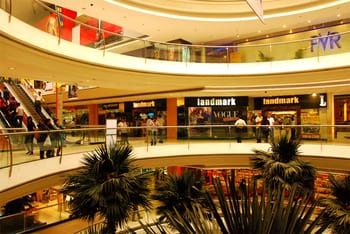
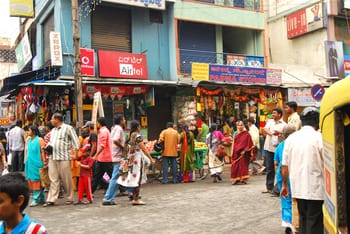
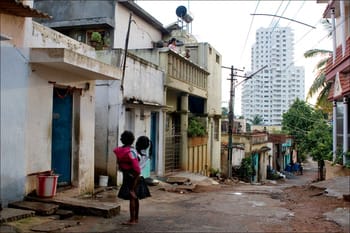
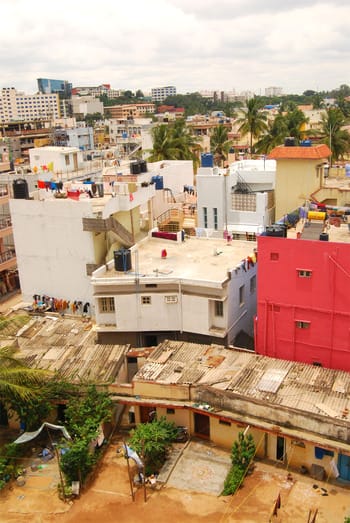
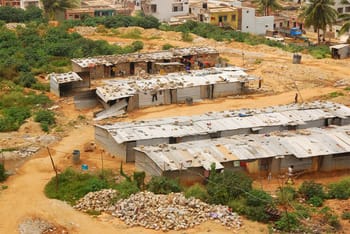
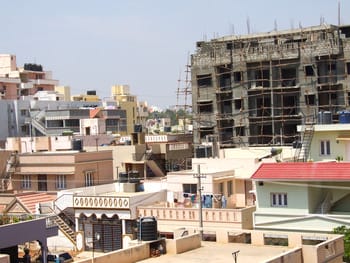
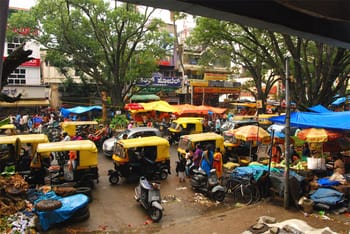
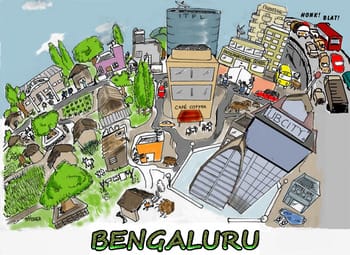
Hi Meera,
It is indeed a very nice article about the present day situation in Bangalore. For the past several days I’ve been googling to find out how as a common-man we could do something about this “unbelievable” traffic in Bangalore. I’m really not interested in writing my views here if it is going to be just another blog which people would read and that’s it!! I am really hoping that my writing here will take some effect in the right direction. As a citizen, I’m ready to set up a campaign and really do something to make our city a better place.
Like you mention, a lot of the IT population thinking is “you can hire a maid who cooks and takes care of the kids, shop, eat at really classy restaurants”. I think all this is happening because there is no concept of “minimum wage” system. In developed countries even a construction worker leads a decent life as the “minimum hourly wage” is in force. I think the greatest problem with us is “enforcement”. As we have no self-discipline, we need someone to monitor us. We are used to this from kindergarten, where we have a class-monitor!!! Can we really do something about this ‘minimum wage system’? Are there any organizations or volunteers already working in this direction?
Thanks,
Aparna.
Hi Meera,
Since there is a restriction of 2000 words per comment, I had to break my comment into three parts.
Here is the continuation.
Next is traffic. I was reading an article on this website which is actually an interview with Mr. Sood, who is the Additional Commissioner of Police. I think I have a few suggestions on how we can control the present day traffic.
1. To put STOP signs at every junction. People need to come to a complete halt and then proceed. The problem here is most of our drivers have a license (in most cases not obtained through proper channels, either by writing a test or taking a road test), but do not know any of the traffic rules. I think through TV and radios people should be intimidated about taking a new driver’s license by end of 2009 or 2010, where everyone has to take up a written test and then a road test. Anybody who fails, should take up the exam again.
2. Having traffic police near schools during drop-off and pick-up times.
3. Proper zebra crossing marks on the roads.
4. Proper footpaths (am I dreaming?), that do not have any trees (especially those humongous ones that cover up the entire width of the footpath).
Thanks,
Aparna.
Hi Meera,
My comments contiued:
5. Those who are constructing or renovating, should not put bricks or mud that cover the footpath or the drainage.
6. The first lessons we give our children should be about our neighborhood and traffic sense than just teaching them ABCD’s and numbers.
Now about parks and playgrounds. We hardly have any. Even if there are, they are mostly not child-safe. The iron slides have such rough edges and the flooring is full of sand which is so full of filth and stones. Here is a link to a playground in the US http://www.americanmatrubber.com/products/rubber_playground.asp . Why can’t we have something like this in our community. A lot of IT people I’m sure would be interested in such things. We could do a fund-raising event to have such a playground in our communities, which could be enjoyed by every child, rich or poor.
All these steps I’m sure are doable. We need to put forth someone who would do it, may be Mr. Praveen Sood himself. Almost everyone in this city grumbles about the issues pointed out here. Why don’t we start taking steps? Let’s not wait for the authorities to do it. Let us do it ourselves. This is after all our city and the place where we have to live.
I would be really happy to see someone replying to me with some positive feedback. Today is Gandhi Jayanthi. Let’s make the first move on a nice day. This reminds me of your article, where Kannadigas are unhappy about not hearing Kannada in Bangalore. I myself being a Kannadiga, think, that it’s time to think as an “Indian”. We should have love towards our mother tongue. Let us show it by reading the novels and poems from our region and teach our kids. But let’s not enforce it on someone who has come to Banglore for a job. Would a Kannadiga working in Pune or Nasik, speak in Marathi? He would rather get away with Hindi or English. Why preach what we don’t follow?!!
thanks,
Aparna.
Dear Aparna,
Most people from north karnataka have a soft corner for Mumbai / Pune even though they have lived in Bangalore for many years. Where are you from?
Regards,
Sudhir
Dear Meena,
Ever since the Gangas of Kolar and Talakadu, the people of Bangalore (both north and south) have not changed. The Brits and the Madaras Regiment used authority to bring a very different population to Bangalore to work for them in Defiance to the local population – Tamils from Madras. These people lived in a ghetto socially cutoff from the Native Bangalorians.
The original natives of north Bangalore may have moved out due to the growth of English, Regimental and Tamil populations. But that influence is limited to a few square Kms. And that land can be traced back to us. So if you want a job get it but remember that is good gesture from Kannidigas. We can never dream of living in Tamil Nadu without learning Tamil. Which means we will never go there to live. But the Tamils who came here because of Jobs from Brits/Madaras Regiment should be thankful to the people of this land.
BTW, Aparna,
Kannidigas working in Pune and Nasik can be either from North Karnataka or Konkan. These are job seeking socities.
Bangalorean natives rarely work outside of Bangalore except where they hold very high positions. We learn Hindi and Tamil so that we can defend ourselves against them but choose not to encourage such things.
Regards
It is nearly impossible to make any hitherto un-thought-of observation about the subject, so let me get straight to saying that this was an excellent read, particularly the rich-poor divide, although I don’t agree entirely.
I have been a part of numerous discussions about the alarming ‘influx’ of ‘outsiders’ trudging in looking for fortunes. I have also been pointed at and told that I belong to a ‘city inhospitable to “guests” ‘. Which one of us hasn’t discussed the traffic malaise anyway?
In spite of it all, the first few lines sum this piece up for many of us. Bangalore, to me, with its hopes and promises, is still a success story! 🙂
Excellent piece of writeup on our bengalooru. Was nostalgic, reading about the city then in comparison to what it is today. I loved the photos of our very own Basvangugi, which I
personally reflects the true Bengalooru and is the heart of the city. Its a feast for the eyes to see all the old bangloreans living here 🙂
> I completely agree about other states showcasing their integrity & Love for their language and find very
less kannadigas out there, whereas its a complete contrast when you walk into Bangalore. You can survive,
speaking any language and hardly find any kannadigas during any social meets or public places.
Northie’s , Tamilian, Telgaits and Keralities rule the place and inspite of these people living
here from ages, hardly know how to speak Kannada. Will I be able to, if the same is ithe case in Tamilnadu?
> We Bangloreans need to go strong on the Traffic control. With the ‘X’ % earning well, their materialistic wants also go up. I have seen many families in my locality having a car for each member in the family.
Is this a requirement (or) an increasing attitude of flambyonce. Its a nightmare to travel in Hosur road and you are half exhaused and irritated, before you reach the workplace.
I agree with Aparna, we need to start taking steps – Follow the rules – SIMPLE. lets do these simple steps and then go to authorities blaming them.